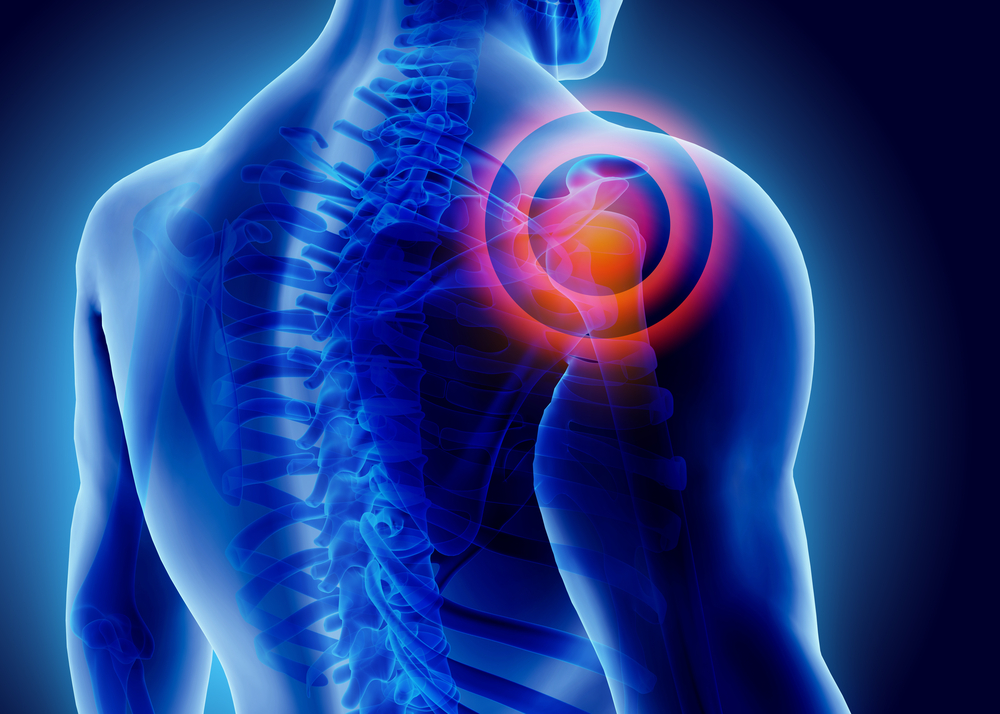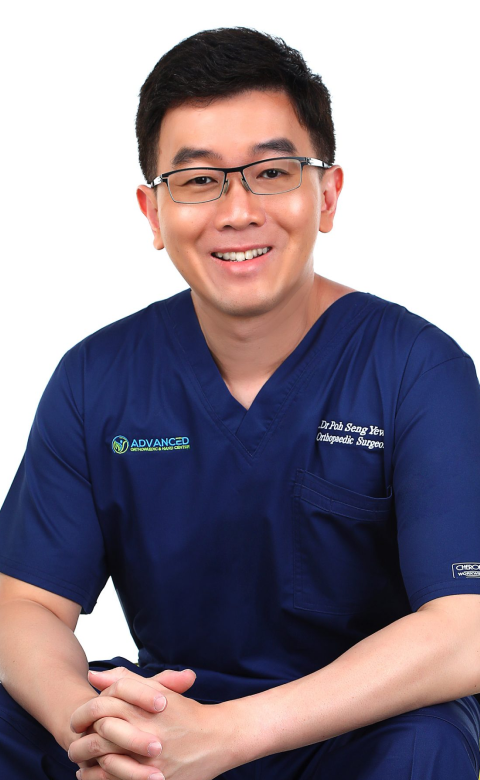Schedule An Appointment Within 24 Hours
Shoulder Arthroscopy Specialist
Dr Poh Seng Yew
MBBS
MRCSEd
MMED (Ortho)
FRCSEd

What Is Shoulder Arthroscopy?
Shoulder arthroscopy is a minimally invasive surgical procedure used to diagnose and treat a variety of conditions affecting the shoulder joint. This technique involves making small incisions to insert an arthroscope, a tiny camera, allowing surgeons to view and repair shoulder tissues with minimal disruption.
Unlike traditional open shoulder surgery, which requires larger incisions and more extensive tissue disruption, arthroscopy offers reduced recovery time and less postoperative pain. This approach is particularly beneficial for addressing issues like rotator cuff tears, labral tears, and shoulder impingement with greater precision and less overall trauma to the patient.
Common conditions treated with shoulder arthroscopy
Shoulder arthroscopy is a highly effective surgical method for treating various common shoulder conditions, offering a less invasive alternative to traditional open surgery. This procedure is particularly beneficial for addressing:
- Rotator Cuff Tears - These are tears in the group of muscles and tendons stabilizing the shoulder joint. Arthroscopy allows for precise repair of these tears, promoting faster healing and reduced pain.
- Labral Tears - The labrum, a cuff of cartilage that encircles the shoulder socket, can tear due to injury or overuse. Arthroscopic surgery is adept at repairing these tears, thereby alleviating pain and restoring joint stability.
- Shoulder Impingement - This condition occurs when the shoulder blade puts pressure on the underlying soft tissues during arm lifting. Arthroscopy can be used to remove or reshape parts of the shoulder blade causing the impingement, thus relieving pain and restoring function.
- Shoulder Instability - Characterized by the shoulder joint becoming loose or dislocating frequently, this condition can be treated by arthroscopically repairing or tightening the ligaments that have been stretched or torn.
- Damaged or Inflamed Tissue Removal - In cases of chronic inflammation or damaged tissue within the shoulder joint, arthroscopy provides a means to remove or repair these tissues, thereby reducing pain and improving mobility.
- Bone Spur Removal - Bone spurs in the shoulder can cause pain and restrict movement. Arthroscopy allows for the precise removal of these spurs, offering relief from symptoms.
Preoperative Considerations For Shoulder Arthroscopy
Before undergoing shoulder arthroscopy, several key preoperative considerations are essential to ensure a safe and effective procedure:
- Medical Evaluation: A thorough medical assessment is crucial to determine the patient’s fitness for surgery. This includes reviewing the patient’s medical history, current medications, and any allergies. Preoperative tests, such as blood work, ECG, and chest X-rays, may be required to assess overall health status.
- Imaging and Diagnostic Tests: Advanced imaging tests like MRI or CT scans are often performed to provide a detailed view of the shoulder’s condition. These images help in diagnosing the specific issue and planning the surgical approach.
- Discussion of Risks and Benefits: The surgeon will discuss the potential risks and benefits of the procedure. Common risks include infection, bleeding, and possible damage to nerves or blood vessels, while benefits include pain relief and improved joint function.
- Preparation Instructions: Patients will receive specific instructions to prepare for surgery, such as fasting for a certain period before the procedure and adjustments to current medications. It’s also important to arrange for assistance post-surgery, as the patient’s mobility will be temporarily limited.
What Does Shoulder Arthroscopy Procedure Involve
The shoulder arthroscopy procedure is a sophisticated surgical technique designed to diagnose and treat various shoulder conditions with minimal invasiveness:
Anesthesia Options |
The procedure typically involves either general anesthesia, where the patient is completely asleep, or regional anesthesia, which numbs the shoulder and arm area while the patient remains awake but sedated. The choice depends on the patient’s health, the complexity of the surgery, and the surgeon’s preference. |
Incision and Insertion of the Arthroscope |
The surgeon begins by making small incisions, usually less than half an inch, around the shoulder. Through one of these incisions, the arthroscope – a thin tube equipped with a camera and light – is inserted. This camera projects images onto a monitor, allowing the surgeon to view the inside of the joint in great detail. |
Inspection and Repair of Shoulder Tissues |
The surgeon thoroughly examines the shoulder joint, identifying any damaged tissues such as torn ligaments, tendons, or cartilage. Additional small incisions are made to insert specialized instruments for the repair process. These instruments can cut, shave, grasp, and anchor stitches into bone. |
Specific Surgical Interventions: |
Depending on the diagnosis, various interventions may be performed. For rotator cuff repair, the torn tendons are reattached to the bone. In impingement syndrome surgery, inflamed or damaged tissue is removed, and bone spurs may be shaved off. For shoulder instability, the surgeon repairs or tightens the ligaments that stabilize the joint. |
Use of Surgical Instruments and Technology |
Advanced technology and specialized instruments, such as shavers, scissors, and suture devices, are used to perform these delicate tasks. These tools allow for precise treatment of the affected areas with minimal impact on surrounding healthy tissues. |
Postoperative Care
Postoperative care following shoulder arthroscopy is crucial for a smooth recovery and optimal outcomes:
- Immediate Post-Surgery Care
After the procedure, patients are typically taken to a recovery area where they are closely monitored as the anesthesia wears off. Vital signs such as blood pressure, heart rate, and oxygen levels are checked regularly. The medical team also assesses the patient’s initial response to the surgery, checking for any immediate complications and ensuring that the patient is comfortable. - Pain Management Strategies
Managing pain post-surgery is a key aspect of care. Patients are usually prescribed pain medications, which may include over-the-counter pain relievers like acetaminophen or ibuprofen, and in some cases, stronger prescription painkillers. It’s important to follow the prescribed dosage and schedule to effectively manage pain and minimize side effects. Additionally, applying ice packs to the shoulder can help reduce swelling and discomfort. - Use of Slings or Other Supportive Devices
Most patients will need to wear a sling for a period after the surgery, typically for a few days to several weeks, depending on the extent of the repair. The sling helps to immobilize the shoulder, allowing the tissues to heal properly. The surgeon will provide specific instructions on how long the sling should be worn and any allowable movements during the initial recovery phase.
Rehabilitation and physical therapy
Rehabilitation and physical therapy are integral components of the recovery process following shoulder arthroscopy, playing a crucial role in restoring function and mobility:
Typical Recovery Timeline
The recovery timeline can vary depending on the specific procedures performed during the arthroscopy. Generally, patients may start gentle physical therapy within a week after surgery. Initial recovery, focusing on reducing swelling and pain, typically takes about 2-6 weeks. Full recovery, especially for more extensive repairs, can take several months.
Physical Therapy and Exercises for Recovery
Physical therapy is tailored to the patient’s specific surgical procedure and individual needs. Early-stage exercises often focus on gentle passive movements to maintain mobility without straining the repaired tissues. Gradually, as healing progresses, the exercises become more active, aiming to restore range of motion, strengthen the shoulder muscles, and improve flexibility. Therapists may use techniques like manual therapy, stretching exercises, and strength training in later stages of rehabilitation.
Guidelines for Returning to Normal Activities and Sports
Patients are usually advised to avoid heavy lifting and strenuous activities for several weeks post-surgery. The surgeon and physical therapist will provide specific guidelines based on the patient’s progress. Typically, patients can return to light activities within a few weeks, but full return to sports, especially those involving overhead activities, may take several months.
Risks & Complications Associated with Shoulder Arthroscopy
Shoulder arthroscopy, while generally safe, carries potential risks and complications, as with any surgical procedure.
Infection: Though rare, infections can occur at the incision sites. Proper wound care is essential to minimize this risk.
Bleeding: Some bleeding is expected, but excessive bleeding may lead to complications.
Pain and Swelling: Postoperative pain and swelling are common but usually subside with proper care and medication.
Stiffness: Some patients may experience stiffness in the shoulder, which typically improves with physical therapy.:
Nerve or Blood Vessel Damage: The proximity of nerves and blood vessels to the surgical site poses a risk, although serious damage is rare.
Anesthesia Complications: Reactions to anesthesia, while uncommon, can occur and may include respiratory issues or allergic reactions.
Deep Vein Thrombosis (DVT): Blood clots can form in the veins, potentially leading to serious complications if they travel to the lungs (pulmonary embolism).

Dr Poh Seng Yew
MBBS
MRCSEd
MMED (Ortho)
FRCSEd
With over 20 years of experience, Dr Poh Seng Yew is an orthopaedic surgeon specialising in hip, knee, shoulder and elbow surgery, sports medicine, and trauma surgery.
- Former Director of Sports Service, Department of Orthopaedic Surgery, Singapore General Hospital
- Clinical Hip and Sports Medicine Fellow, Orthopädische Chirurgie München (OCM), Germany
- Fellow, Royal College of Surgeons of Edinburgh, FRCSEd (Orthopaedic Surgery)
- Master of Medicine (Orthopaedic Surgery), National University of Singapore
- Member, Royal College of Surgeons of Edinburgh (MRCSEd)
- Bachelor of Medicine, Bachelor of Surgery (MBBS), National University of Singapore
Insurance
Shield Plans
Corporate Partners




Mount Elizabeth Novena Specialist Centre
38 Irrawaddy Road, #08-62/63
Singapore 329563
Weekdays: 9.00am – 5.00pm
Saturdays: 9.00am – 1.00pm
Sundays and Public Holidays: Closed
Need Advice On Your Condition?
Please leave us a message, and we will be in touch with you shortly.
Mount Elizabeth Novena Specialist Centre
38 Irrawaddy Road, #08-62/63
Singapore 329563
FAQs for Shoulder Arthroscopy
Can I drive after shoulder arthroscopy?
Driving is not recommended until you regain full control and strength in your shoulder. This typically means waiting until you no longer need a sling and have your surgeon’s approval.
Will I need help at home after the surgery?
Yes, it’s advisable to have someone assist you for at least the first few days post-surgery, as your mobility will be limited and you’ll be wearing a sling.
How soon after the surgery can I shower?
You can usually shower within a few days, but you should keep the surgical area dry until your surgeon advises that it’s safe to wet the incisions.
Can shoulder arthroscopy be repeated if problems persist?
In some cases, repeat arthroscopy may be necessary, but this depends on the individual’s specific condition and response to the initial surgery. Your surgeon will evaluate and recommend the best course of action.
